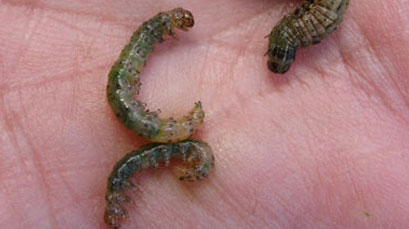There’s nothing quite as beautiful as a lush, green lawn. It creates an inviting look to your home, gives you a place for your kids to play, and a space to host your family and friends for get-togethers. In the unfortunate event of a pest invasion, your lawn can quickly become sickly and brown. While seeking lawn service in Utah, or treating yourself, it’s important to know about the various pests that threaten the wellbeing of your grass.
Sod Webworms
Sod webworms are one of the most widely recognized pests affecting lawns in Utah. They destroy lawns by eating grass blades and entire stems, leaving behind patches of brown, dying grass. Luckily the damage caused by these pests is aesthetic and easy to remedy.
These destructive pests are the larvae of the sod webworm moth. Each year sod webworms will lay eggs on blades of grass at night. Within seven days the eggs hatch and the larvae feed on the grass at night. During the daytime, they hide in the holes created by birds attempting to forage for worms. The sod webworms lay two to three generations of eggs each year during the spring and summer.
Mature sod webworms are about 1 inch in length and are brown or green with dark spots. The adult moth is a dingy tan-grayish color with a distinctive double snout-looking protrusion coming out of its head.
The Common Crane Fly
One of the most newly detected lawn pests is the common crane fly. It is most often found in golf course greens but a few species’ larval stage is known to feed on turfgrass, making them something to keep an eye out for. Like the sod webworms, the damage caused by these pests is more aesthetic, causing ugly brown spots on your lawn. If your lawn is healthy it can withstand high numbers of the larvae and will easily recover. It’s important to keep your lawn properly maintained to fight off these pests.
Crane flies are often mistaken for mosquitoes or daddy long-leg spiders. They are easily recognizable thanks to their long, delicate legs.
Chinch Bugs
Chinch bugs are another common lawn pest you may encounter in Utah. These tiny insects can cause a lot of damage to your lawn if they’re not controlled. They damage your grass by removing the sap from the blades of grass and injecting their saliva into it. Their saliva contains an anticoagulant that prevents water from traveling up the blade. They oftentimes cause the most damage in the sunny areas of lawns.
Chinch bugs are very small, measuring about 1 ¼ millimeter in length. They have black bodies with shiny white wings. Female chinch bugs lay eggs on the underground roots or in the folds of grass blades. The eggs will hatch through mid-to-late-spring, while the next generation hatches in mid-to-late-summer.
Grubs
Grubs, or beetle larvae, are one of the most dangerous pests to lawns in Utah. They cause rampant damage by feasting on the roots of your grass. These pests tend to create brown spots that can spread throughout the rest of your lawn.
Adult female beetles lay eggs in the soil during midsummer. After two weeks, the eggs hatch and the grubs begin their life cycle by feeding on the roots of the grass. As winter approaches the grubs bury themselves underground to avoid freezing and remain dormant until early spring. During early spring they return to eating the grass roots until they mature into adult beetles, restarting the lifecycle.
There’s a simple trick to help if you’re unsure if you have grubs or if your grass isn’t getting enough water. Before your sprinklers start running, place a bowl in the dead patch of grass that you’re concerned about. After the sprinklers run, check the bowl to see if it has filled with water– it should be filled with ¼ inch of water for every 15 minutes the sprinklers were running. If there is enough water in the bowl, you may have a grub issue.
Trust Lawngevity for Your Yard Care
To keep your lawn looking lush and beautiful, trust the experts at Lawngevity. We offer a variety of landscaping and yard services to keep your yard looking healthy and beautiful. To learn more about our services, contact us today at 801-618-2785.


